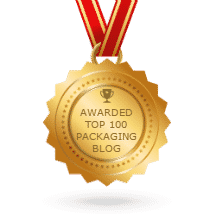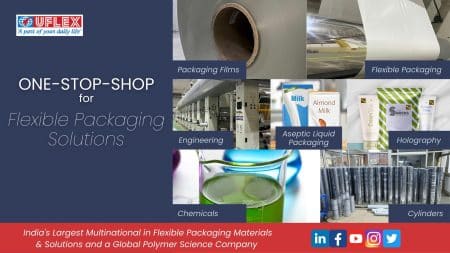If there were binoculars to decode the future of packaging on the trends we all are observing today, it would not be difficult to say that technology that authenticates, and materials that are eco-friendly are set to traverse the future of packaging to an entirely unimaginable territory.
The sector is going through a massive shift, be it the use of mono-materials, Biodegradable Packaging materials, digitalization of packaging, the advent of innovative user-friendly packaging structures, and increase in eco-conscious consumers. However, the challenge for businesses remains to accommodate consumer expectations while finding the middle ground between the e-commerce boom, technology, sustainability, and delivering smart Flexible Packaging solutions.
According to research by Smithers in The Future of Packaging: the global packaging market is set to expand by almost 3% per annum, to reach over $1.2 trillion. The switch from mass manufacturing toward customized and innovative packaging has a major force to drive this growth and provides a full-fledged experience that appeals to the consumers’ mind, emotions, and senses in ways that transcend beyond the brand as a product.
What is Trending in the World of Packaging?
Edible packaging is an integral part of food and is eatenas a consumable coating around the food that generates practically no waste! Sourcing raw materials from algae, starch, fruits and vegetables’ skins, etc, have opened doors for innovative packaging solutions. This trend will not only help tackle the problem of plastic but it would also be a whole new experience for customers to see what goes beyond the packaging too! According to Transparency Market Research, a global research firm, demand for edible packaging could increase on average 6.9% yearly until 2024 and could become a market worth almost $2 billion worldwide.
Similarly, Smart Packaging formats are emerging to be a unique digital bridge between brands, retailers, and buyers. Tech innovations are set to add new functionalities to what is currently used as a packaging material to protect the product inside. It is interesting to note that packaging is gradually becoming more communicative, with a rather digital touch. Smart Packaging is usually of two types- intelligent and active packaging. Active packaging interacts with the contents and helps extend the shelf life, often using light filtering materials, oxygen and ethylene absorbers, moisture-regulating compounds, etc. Intelligent packaging refers to technologies that monitor and provide information on the state of the products, from source to destination. With the use of indicators, data carriers, and sensors, directly incorporated into the packaging, a new realm of communication is slowly but strongly emerging. According to Grand View Research, smart packaging revenues came in at $10.8 billion in 2015 and are expected to reach $26.7 billion by 2024.
The rise in innovative design concepts for products not only helps in being cost-effective but going forward will become vital for functional packaging. The packaging of tomorrow will call for a diverse range of shapes and sizes, maximizing space, storage, and service. The use of RFID labels and smart tags by manufacturers will help secure their products’ authenticity as well as integrating printed electronics will improve brand identity, offering flexibility, and efficiency with a more sustainable approach. Smaller but smarter spaces might just become the new standard!
The Rising Wave of Sustainability
With sustainability becoming the most dominant trend in packaging, brands are aggressively focusing to incorporate Flexible Packaging Solutions across their product range, representing their strong commitment to keeping the earth green. With restrictions, stringent compliances and different types of bans getting enforced across the world, recycled packaging options are more preferred by brands and even by environmentally conscious consumers. Survey by new age agencies such as Survey Monkey indicate, 35% of respondents would purchase a product that is better for the environment over other products that may be slightly cheaper. Packaging solutions companies are working toward eliminating plastic waste, increasing the use of sustainable materials such as mono-materials and corrugated boxes that reduces the pressure of plastic waste on land and help build a circular economy.
Walking In Tandem With The Trends at UFlex
Redefining customer experience, progressing toward more efficient and sustainable practices, and venturing into new territories with technology will soon become the future of packaging. The brands that can adapt and accommodate these new trends into their packaging solutions will be the ones a step ahead of the game.
India’s largest multinational in flexible packaging solutions, UFlex has been delivering innovative, optimized, and efficient packaging solutions for decades now! Serving as a one-stop-shop for a multitude of flexible packaging needs, UFlex has a diverse range of futuristic world-class products including BOPET (Bi-axially oriented polyethylene terephthalate) films, BOPP (Bi-axially oriented polypropylene) films, CPP (Cast polypropylene) films, Metallized films, Alox Coated films and up to 100% PCR content PET Films Asclepius. The company is second largest supplier of thin polyester (BOPET) films in the world used for manufacturing flexible packaging applications.
The focus on quality innovation emanates from the conviction to deploy advanced technologies coupled with best-in-class equipment that add maximum value to the customer’s business. We remain committed to our efforts in providing world-class operational excellence by methodical elimination of losses in each area of operation. The focal point incessantly lies in sustainability as we progress to reduce plastic waste and create products & solutions that are recyclable, biodegradable, and non-fossil fuel-based and traverse the gamut of packaging to a territory of faith and virtue.



